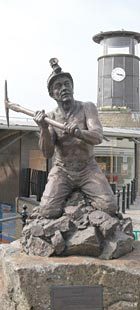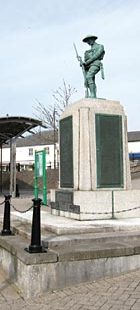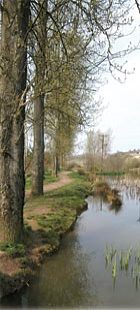The historic market town of Cinderford in the very
heart
of the Forest of Dean.
The ford, from which the town’s name is derived, was replaced by a bridge in 1674, when improvements were made to the town following the Civil War. The original settlement in the area was a small collection of houses, built just before 1800, along the edge of the forest boundary. These buildings, known as "encroachment" cottages, were built just inside the forest at a time when it was illegal to build houses on the land of the Royal Forest.
With its elevated position in the very heart of the Forest, Cinderford offers some fine views of the River Severn and surrounding area. This former mining town and industrial capital of the Forest is quietly undergoing a revival, attracting new businesses into the area. The centre of the town, called The Triangle, has two fine sculptures – the town's war memorial plus a statue of local freeminer, Dave Harvey.
Cinderford itself is one of the main commercial centres of the Forest of Dean, and offers an excellent variety of shops, as well as a thriving open air market. There are also 28 local pubs, cafes and restaurants, covering everything from Indian and Chinese to traditional English food, as well as locally brewed beers.
The town is virtually surrounded by forest, so residents and visitors are ideally placed to take advantage of many acres of beautiful woodland. plus a range of top quality films which are shown in its wonderfully restored Edwardian theatre, the Palace Cinema.
Cinderford Artspace is a relatively new venue which showcases work by local and national crafts-people and artists. Nearby in Soudley is one of the area's premier visitor attractions, the Dean Heritage Centre, which offers a fascinating insight into the area's past. It also allows visitors the opportunity to see traditional craftsmen at work, view art exhibitions at The Gallery, plus it organises a range of interesting family events throughout the year.
Just outside Cinderford lie the villages of Littledean, Drybrook and Ruardean all of which offer a good range of welcoming, country pubs and inns. Ruardean is also known for being the birth place of the founders of Horlicks Malt Milk, James and William Horlick.
The town and its surrounding area offer a great variety of things to see and do. The Dean Heritage Centre, run by the Dean Heritage Museum Trust, is dedicated to preserving the history of the Forest of Dean.
There are five galleries demonstrating how the landscape and character of the area has developed from thousands of years of interaction between the people of the Forest of Dean and its natural environment. It is housed in an old corn mill, constructed in 1876, and is now one of the main visitor attractions in the area.
For the more energetic, there is the three mile long Sculpture Trail through the Forest. This features several pieces, including a spectacular stained glass window suspended amongst the trees, and a Giant’s Chair. The Trail begins and ends at Beechenhurst, a picturesque picnic site.
A recent and welcome development in Cinderford itself is Linear Park, a wildlife conservation site, which boasts a cycle path as well as footpaths, and takes the route of the former railway branch line. There are many other attractions, as well as Festivals and Events, and a Tourist Information Point at the Belle Vue Centre, where details on all of these can be obtained. |
The coal miner in Cinderford’s Triangle reminds visitors of
our industrial heritage
 Cinderford remembers the Cinderford remembers the
fallen of two World Wars

Cinderford’s tranquil
linear park
|